Did you know that Whale sharks are not whales at all but the planet’s largest fish?
However, unlike the Great White shark in the “Jaws” movie, these 40-foot gentle giants pose no threat to people, feeding on plankton rather than surfers!
Despite being mostly seen in isolation, these creatures often assemble in numbers where food is abundant, traveling vast distances in search of a meal.
If you want to see Whale sharks, the warm waters of the western Indian Ocean or the Maldives are a good bet, although they can be found in tropical and warm temperate seas throughout the world.
But why are Whale sharks endangered? Are we to blame for their declining numbers?
Read on to learn more about these magnificent fish.
Whale Shark
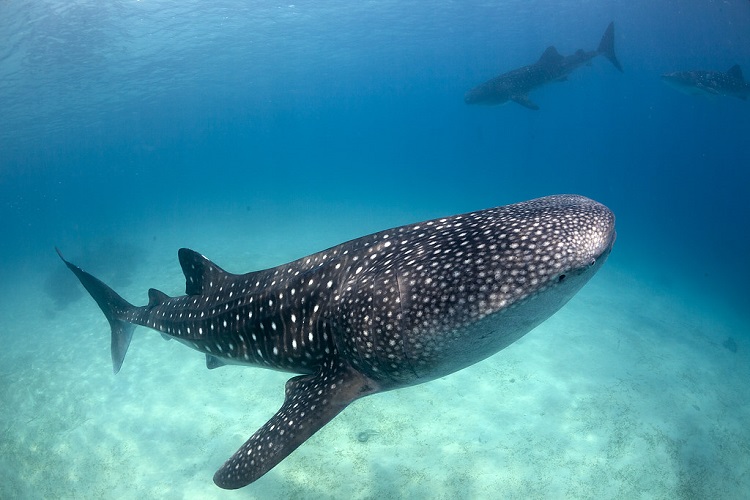
The Whale shark having the scientific name Rhincodon typus and belonging to the family Rhincodontidae and genus Rhincodon, is not a whale but a shark. In fact, these beautiful creatures are the planet’s largest fish.
You’ll find individual Whale sharks cruising peacefully through all the tropical and temperate oceans of the world, traveling vast distances to feed on plankton. Adult Whale shark species are often seen feeding at the water’s surface, but they can dive to depths over 3,000 feet in search of food.
Female Whale sharks give birth to live young, although that’s never been seen, and where the juveniles grow and mature is unknown.
Whale sharks are classified as endangered, and numbers are declining in some areas, although the creatures are protected from fishing in many countries.
Physical Description
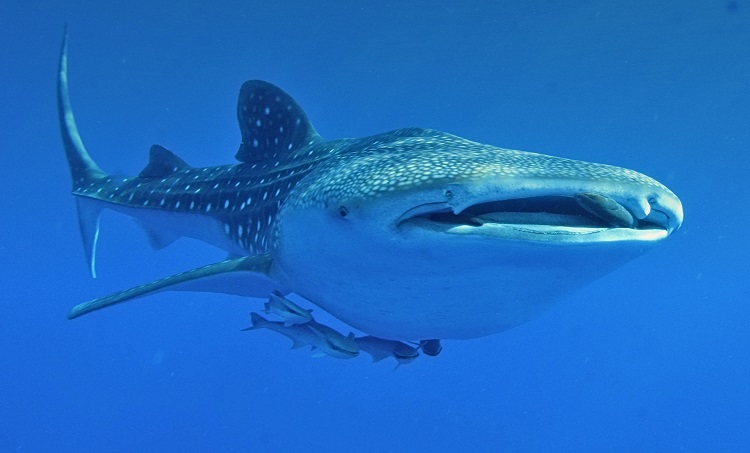
Whale sharks are extremely distinctive to look at, and not just because of their gargantuan size. That’s good news for keen wildlife spotters, as you can often see these fish when watching from the shore.
What Does a Whale Shark Look Like?
The Whale shark has a flattened head with a blunt snout above the creature’s mouth. In addition, short barbels or whiskers protrude from the shark’s nostrils.
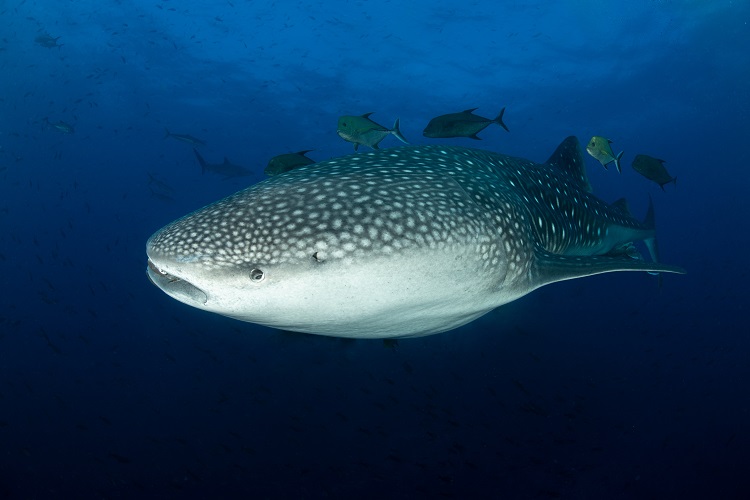
Whale sharks are brown to gray in color on their sides and back, with pale vertical and horizontal stripes and a white belly. The sharks have two dorsal fins set rearward of the body, ending in a large dual-lobed tail fin.
Unique Identifiers
These beautiful animals have white spots across their bodies. Every shark’s spot pattern is unique, like human fingerprints, which enables individual sharks to be identified and cataloged, helping to keep track of their numbers.
For example, according to WWF records, 458 different Whale sharks have been identified in the Philippines alone.
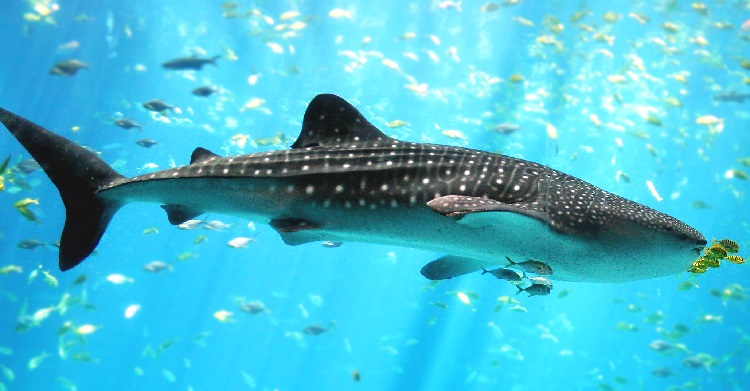
But those unique spotted “fingerprints” have long perplexed scientists. Whale sharks are pelagic animals, living only in the open oceans, but spotted patterns are a feature most commonly seen on benthic or bottom-dwelling species as camouflage.
Whale sharks belong to the Orectolobiformes order, commonly called “carpet sharks.” Most of the species in this order are benthic species, so it’s thought that those characteristic white spots could be a remnant of the Whale shark’s evolutionary past.
However, more random theories suggest that the spots are some weird form of communication between individuals or could help protect the sharks from harmful UV rays while feeding at the surface.
How Big Is a Whale Shark?
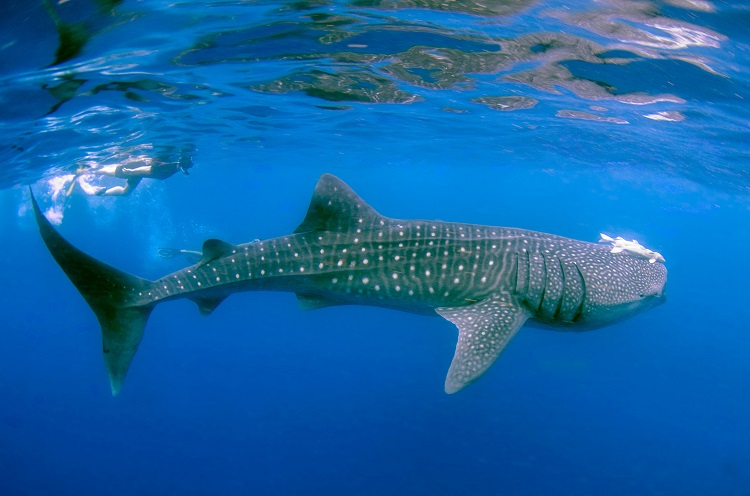
The Whale shark holds the record for the largest living nonmammalian vertebrate!
Wild adult Whale sharks can measure between 18 and 32.8 feet long, which is about the same length as a bus! However, there are exceptions to that rule, and the maximum length of a Whale shark was measured at a whopping 61.7 feet!
Female sharks are generally larger than males.
Whale Shark’s Weight
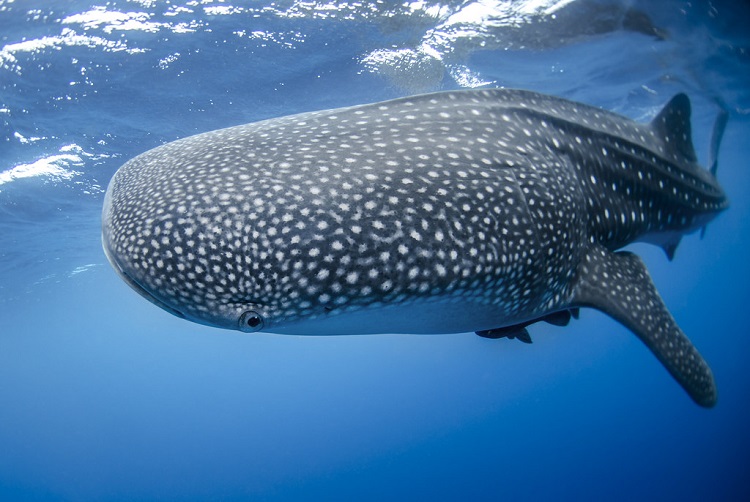
Despite the huge distances the sharks cover, we reckon that plankton must be pretty high in calories, as these massive fish can weigh in at around 20.6 tons!
Whale Shark Habitat
Whale sharks are found in all temperate and tropical oceans, frequenting both coastal and oceanic habitats.
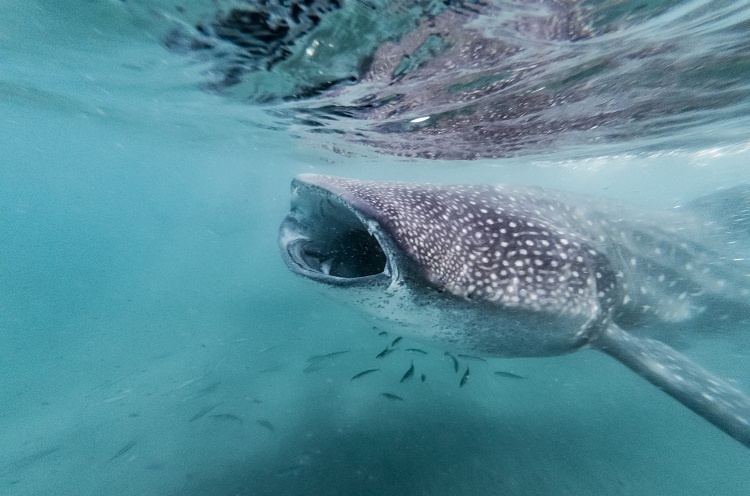
According to IUCN data, some Whale sharks have been seen in cooler waters, including off the coast of New York, but around 75% are found in the Pacific and Indian Oceans, with 25% in the Atlantic.
Growth and Reproduction
The Whale shark’s lifecycle is still something of an enigma, but here’s what we know.
The shark’s massive size implies that they grow slowly and live for many years. A male Whale shark isn’t sexually mature until it’s at least 30 years old. In contrast, females are typically 50 years old before they are able to conceive.
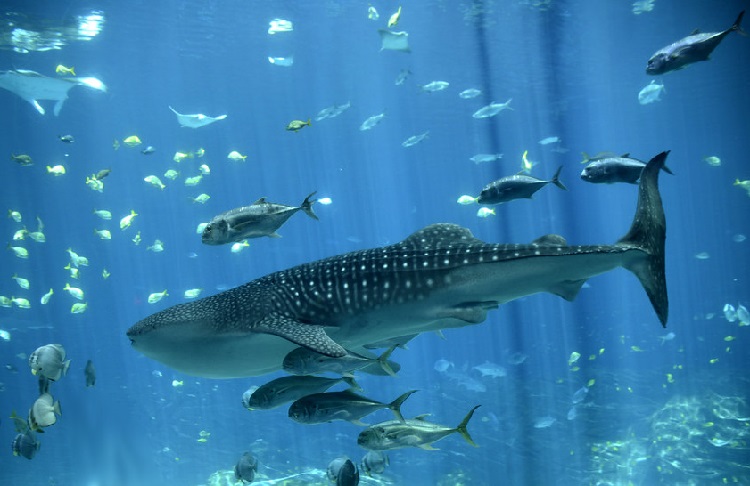
Female Whale sharks are ovoviviparous. That means the sharks produce eggs, which hatch inside the mother shark instead of in the water. Once the baby sharks, or pups, have matured inside their mother, she gives birth to them.
How Do We Know That?
So, back in 1995, a pregnant female Whale shark was caught in fishing nets. Examination revealed that “Big Mama,” as the shark was nicknamed, contained 300 embryos in various stages of development, one of which was 25 inches long.
Where Do Baby Whale Sharks Go to Grow?
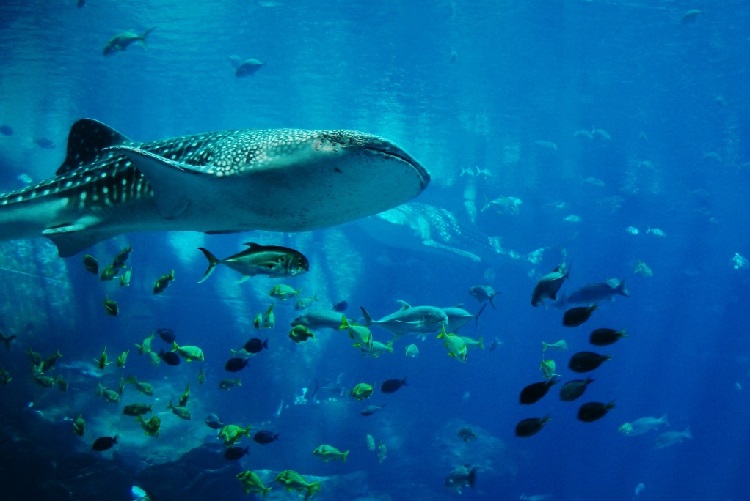
It’s thought that Whale sharks give birth in the deep ocean, where the pups remain until they are large enough to venture into shallower waters safely.
However, to date, the only pups seen are neonates that have been caught in fishing nets; their nursery habitat is only conjecture.
Whale Shark Diet
Whale sharks are carnivores. However, unlike many of their smaller cousins, these sharks are not predatory hunters with rows of razor-sharp teeth. Instead, the benign Whale shark is a filter feeder, existing primarily on a diet of plankton.
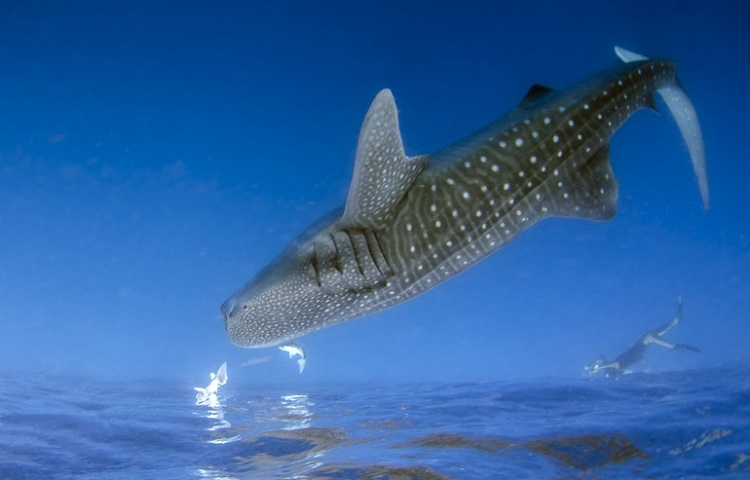
In addition, these enormous sharks have 300 rows of tiny teeth that enable them to supplement their diet by gulping down shrimp, sardines, mackerel, squid, albacore, small fish, jellyfish, and anchovies.
The sharks also eat fish eggs, sometimes waiting for hours for small fishes to spawn on reefs before gliding in to gobble up the eggs.
When you consider that an adult Whale shark has a gape of around 4 feet, you can see just how much these creatures can eat in one gulp!
Feeding Methods
Whale sharks use two methods to feed:
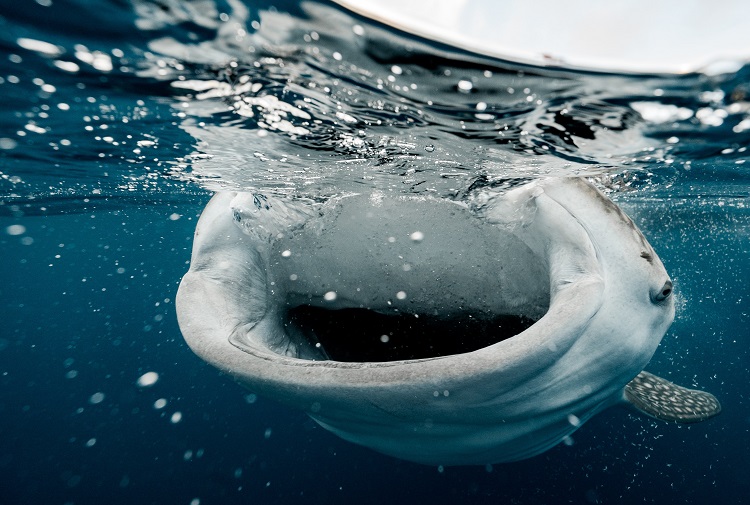
- Surface ram filtration feeding involves the shark swimming forward along the water’s surface with 85% of its mouth submerged.
- Active suction feeding sees the shark opening and closing its mouth to create suction. That method enables the shark to pull in higher volumes of water and prey into its gaping maw.
The Whale shark’s pharyngeal cavity has a specialized filtration system of filtering pads or gill rakers that filter any food items and send them to the back of the shark’s throat.
Simultaneously, water is expelled through the shark’s gill slits. If the gill rakers become clogged with debris, the Whale shark “coughs” to clear them.
Whale Shark Facts
Here are a few fascinating facts about sharks and their behavior.
Migration
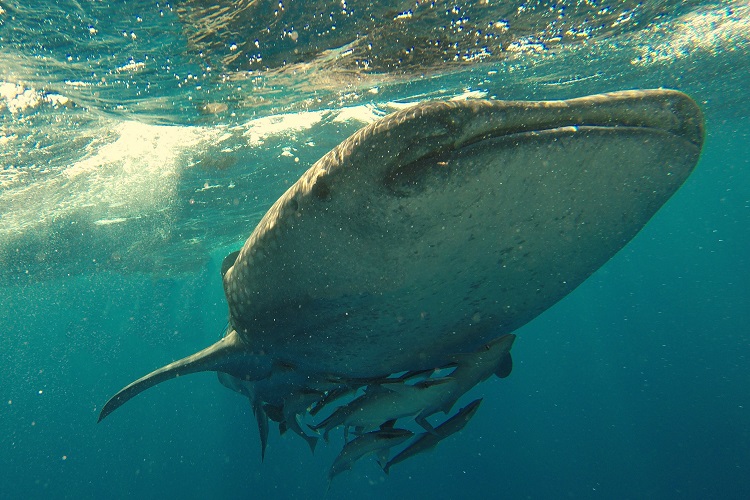
There are more questions than answers when it comes to Whale shark migration. However, there have been some successful tagging efforts that show these creatures are highly nomadic.
Whale sharks are usually solitary, coming together for just a few months every year in huge gatherings to feed in plankton-rich waters. Once feeding is complete, the sharks wander away again in random directions, often vanishing into the blue depths during Spring and Winter.
Behavior
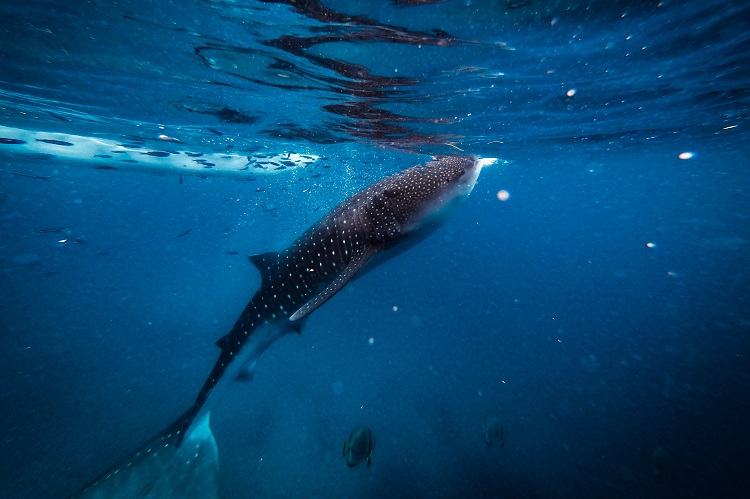
Scientists think that the sharks migrate along the northeastern Yucatán Peninsula, the Gulf of Mexico, and the Caribbean between May and September.
It’s thought that migration is primarily driven by the search for food but might also provide the opportunity to breed and give birth, although that’s so far unproven.
Little else of note is known about the behavior of these mysterious sharks.
Swimming
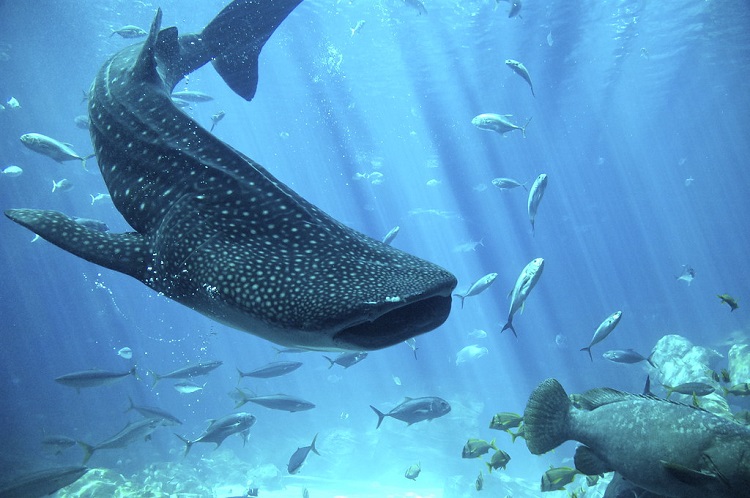
Whale sharks swim at a speed of around 3 mph, often traveling up to roughly 18 miles per day in their search for food. An individual Whale shark will spend around 7.5 hours per day foraging, consuming up to 3 pounds of plankton every hour.
Lifespan
Like many large animals, it’s thought that the enormous Whale shark can live for up to 100 years or even more.
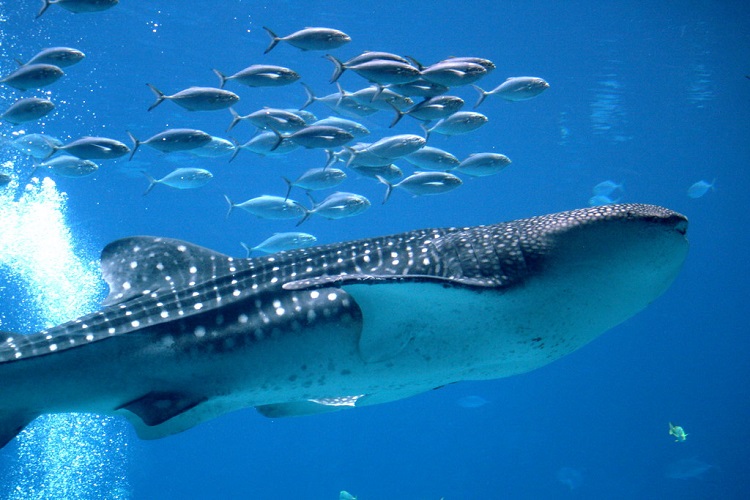
Once mature, Whale sharks have few natural predators, although pods of Orca are thought to prey on these sharks if encountered. Smaller individuals can sometimes fall prey to Blue sharks and Blue marlins, but the most serious threat to Whale sharks is thought to be from humans.
Where to See Whale Sharks
The best places to see Whale sharks in their natural environment are:
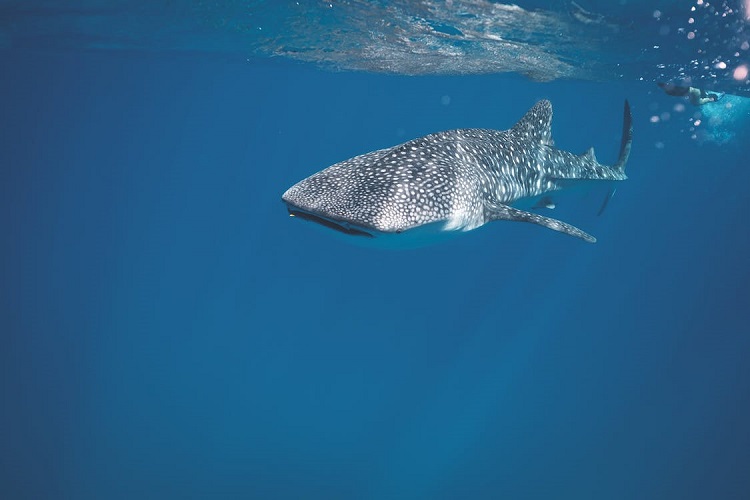
- Ningaloo Reef, Western Australia, from March to July. The sharks assemble here to gorge themselves on the coral mass spawning that takes place.
- Mafia Island, Tanzania, between October and February when plankton is pushed out into the ocean from the Rufiji River.
- The Galapagos Archipelago, Ecuador, between June and December. Whale sharks travel to the Wolf and Darwin Islands, where three ocean currents converge, creating a nutrient-rich upswelling. Scientists think that Whale sharks come here to give birth, although that’s not yet been proven.
- Isla Holbox, Mexico, between June and September. Whale sharks come to these warm, fertile waters to feed and breed.
- West Papua, Indonesia. Although Whale sharks live in Cenderawasih Bay year-round, their numbers increase dramatically during the plankton bloom between October and April.
- Maldives. You can usually spot Whale sharks year-round in the Maldives, with the best spots being Baa Atolls and South Ari between May and November when the sharks gather to feed on a large plankton bloom.
In some of these off-the-beaten-track locations, divers can buy a permit to swim with these amazing animals. However, the presence of humans can disturb the sharks feeding, and one swipe from that huge tail could be fatal, even if not malicious!
Whale Shark Population
It’s estimated by researchers from various scientific bodies, including the IUCN, that there are between 128,000 and 200,000 adult Whale sharks left in the world’s oceans today. However, since these creatures are difficult to tag and track, the global Whale shark population can only be estimated.
The Indo-Pacific population of Whale sharks alone is thought to have declined by around 63% over the last 75 years, and that decrease is mirrored in other oceans.
For that reason, the Whale shark is now listed on the IUCN Red List as endangered with blue whales.
Threats and Conservation Status
So, what’s causing the dramatic and worrying decline in Whale shark numbers?
Unfortunately, but not surprisingly, human activity is the main danger to these magnificent creatures.
Fishing
The fishing industry is the prime culprit for the Whale shark’s tragic decline. During the 1990s and 2000s, several Asian Whale shark fisheries closed, which was great news for conservationists and other sharks.
However, the shark’s flesh and fins are still in high demand and considered a delicacy in some Asian cultures. The shark’s oil is also prized for waterproofing boats.
Despite a widespread ban on hunting Rhincodon typus, countries, including India and China, persist in hunting the species. It’s estimated that, in China, up to 600 Whale sharks are taken each year.
Ironically, both China and India are signatories of the Convention on International Trade in Endangered Species (CITES).
Bycatch
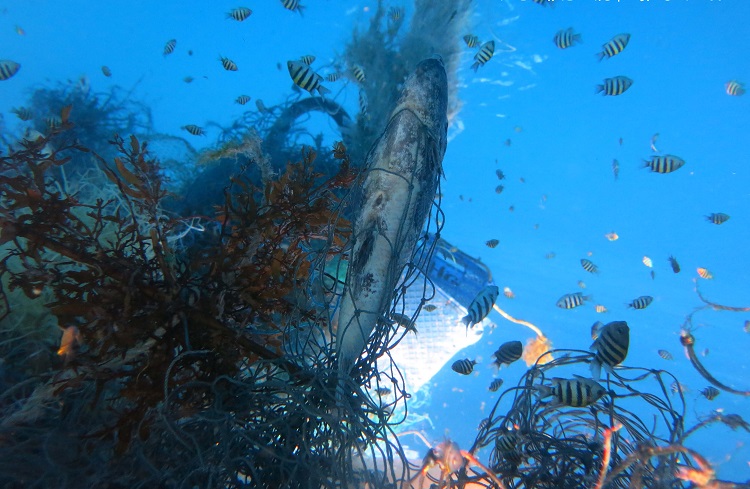
Although most commercial fishing operations don’t set out to catch Whale sharks, dangerous, reckless fishing techniques and illegal fishing gear often take the sharks as bycatch.
Whale sharks and tuna are often found swimming in close proximity to each other. So, armed with that knowledge, fishermen use the presence of the sharks to locate large tuna schools. The unscrupulous even use purse-seine nets around the sharks to maximize their tuna catch.
Some styles of fishing, such as ghost nets, leave Whale sharks so entangled that they drown.
Tourism

Rather than fishing for and killing Whale sharks, many nations have begun exploiting the creatures as a major draw for eco-tourists.
Although that’s undoubtedly laudable, the sharks’ feeding can suffer from the disturbance caused by divers, snorkelers, and tourist shark-watching boats.
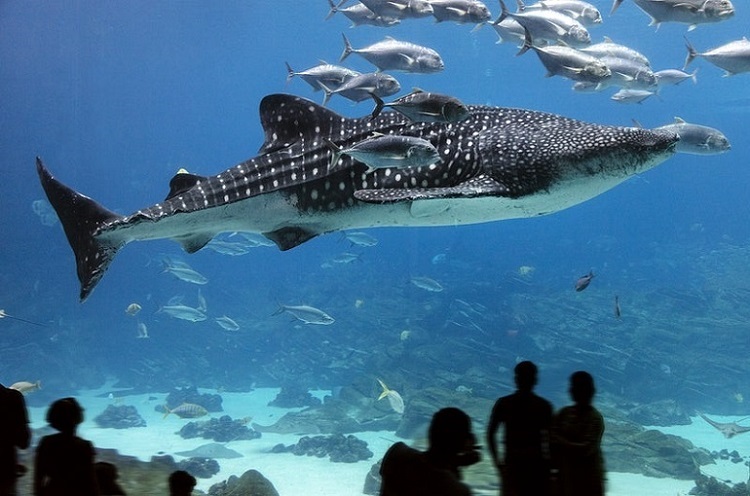
Injuries
Whale sharks primarily feed on or just below the water’s surface, and since many of the sharks’ migration routes take them through major shipping lanes and fishing grounds, the creatures are often injured or killed by propellers and vessel strikes.
In addition, the noise and disturbance caused by large cargo ships degrade much of the sharks’ prime feeding grounds.
Poisoning
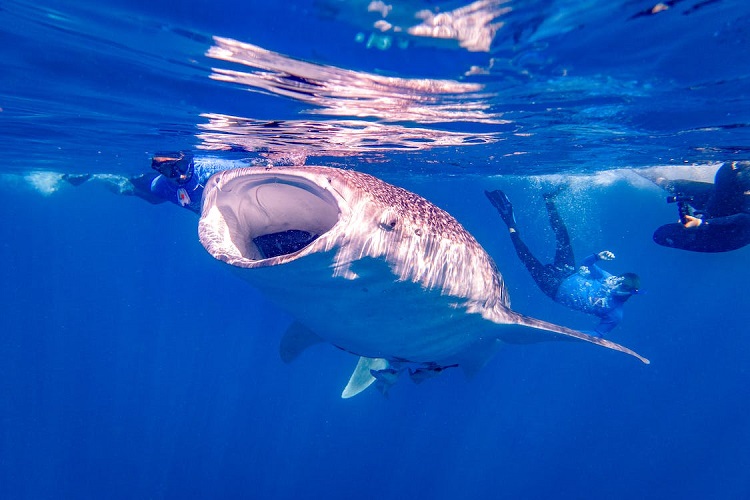
As filter-feeders, Whale sharks are at risk of ingesting indigestible or toxic pollutants. Indonesian studies have shown that Whale sharks swallow thousands of micro-plastic particles every hour while filter-feeding on plankton.
Sharks also ingest other items of debris, such as soda cans, bottles, and general detritus, and run-off from agricultural land can bring toxic chemicals and fertilizers into their habitat.
What WWF Is Doing for the Whale Shark?
Experts at the WWF study Whale shark habits and collect information on individual animals by using sonar devices, digital cameras, and satellite tags to keep track of the sharks.
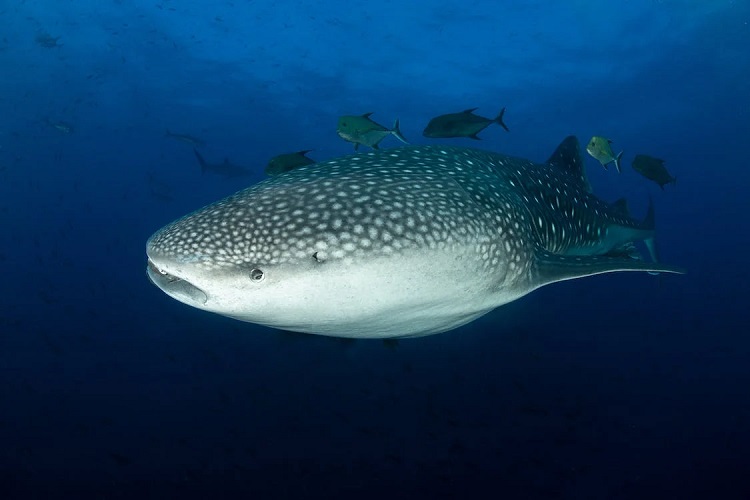
Individual sharks can be identified by their unique spot pattern, and records are kept in a computer database. That enables the WWF to monitor the movements of certain sharks from a particular area, helping us to understand more about the creatures’ behavior.
In particular, WWF supports studies that are used to learn about the Whale shark population, habitat use, and migratory routes around Mafia Island in Coastal East Africa.
How Can You Help?
You can help save Whale sharks by going to the WWF website and signing up for their symbolic animal adoption program.
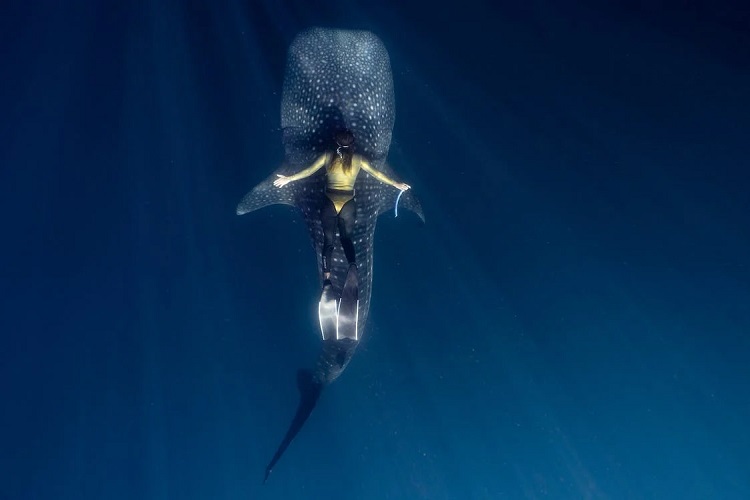
By doing that, you will be supporting WWF’s conservation efforts and helping to save this endangered species, as well as protecting the fragile ecosystem that the animals live in and building a future where people can live in harmony with the planet and its inhabitants.
WWF offers some gorgeous Whale shark-themed clothing items, buttons, etc. Why not treat yourself or someone you care about to something from the collection and help raise awareness of the plight of these threatened sharks?
Relationship with Humans
Below is some amazing information about the relationship between humans and Whale sharks.
Behavior with Divers
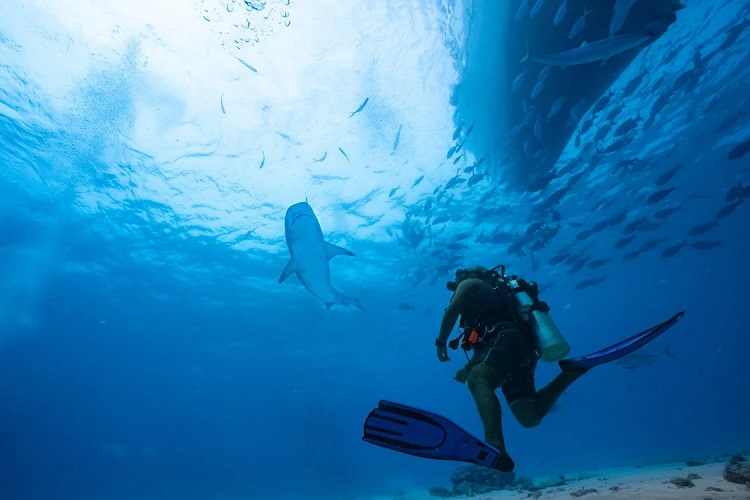
Despite their enormous size, Whale sharks pose no danger to people.
In fact, these gentle, docile fish sometimes allow swimmers to interact with and even ride on them. However, that practice is discouraged because of the disturbance it causes the sharks.
A juvenile Whale shark will often play gently with divers and seem to enjoy the experience as much as the human participants in the game.
Whale Sharks in Captivity
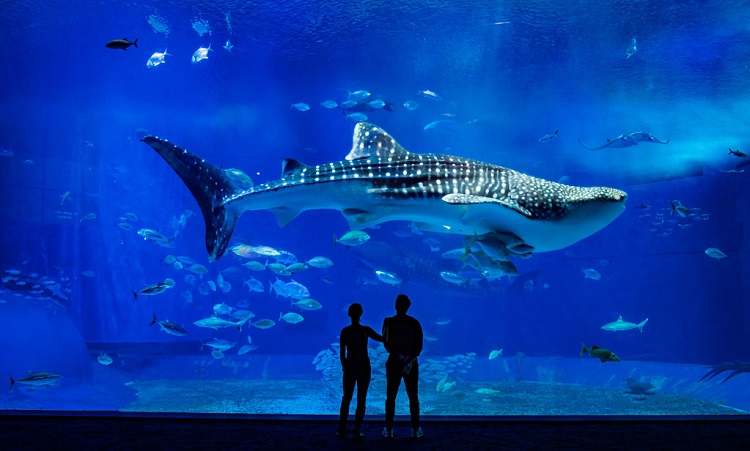
We do not condone keeping these majestic ocean-going creatures in captivity. Although individual Whale sharks are naturally solitary, that environment simply doesn’t enable the sharks to behave as they would in nature and only serves to deplete already dwindling wild populations.
That’s borne out by the early death of some captive sharks in some Chinese public aquariums, where the fish were restricted to very small tanks.
The first place to keep Whale sharks outside of Asia is Georgia Aquarium in Atlanta, US. However, the 28 to 36-hour journey to bring the sharks to the aquarium was undoubtedly stressful and could have proved disastrous.
The aquarium has two male Whale sharks called Yushan and Taroko that arrived in 2007, replacing two earlier sharks that died that year. The sharks were imported from Taiwan, having been rescued from the country’s commercial fishing quota, effectively saving them from ending up on someone’s table.
Thankfully, bowing to pressure and worldwide condemnation, Taiwan closed that fishery for good in 2008.
Importance in Culture
Whale sharks are important in human culture and are revered in some countries.
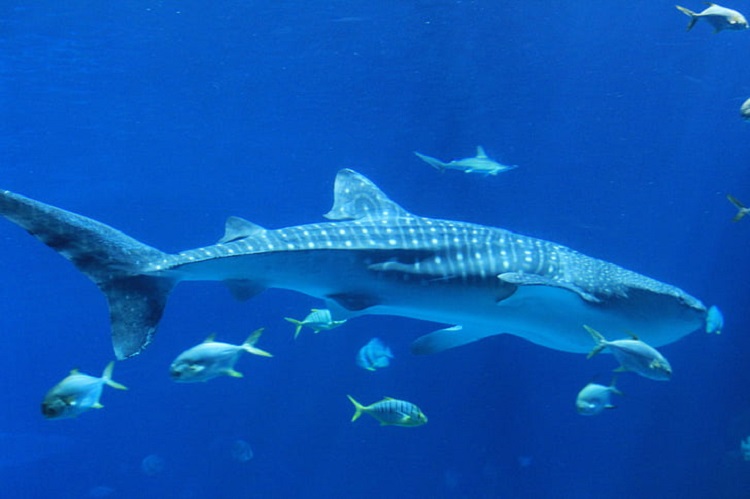
- In Madagascar, the Whale shark is commonly known as marokintana, which means “many stars,” after the unique spotting pattern on the shark’s body.
- Whale sharks are called balilan and butanding in the Philippines, where the creatures appear on the reverse of the 100-peso bank note.
- In the Philippines waters, snorkelers must keep a distance of at least 4 feet from Whale sharks. Anyone flouting that law could face a fine and a prison sentence, especially if they touch or interact with the animals.
- Japan calls Whale sharks jinbei-zame, again because the sharks’ markings closely resemble the patterns typical of jinbei, a traditional set of garments worn by women, children, and men during the summer months.
- Indonesians know Whale sharks as gurano bintang.
- In Vietnam, the Whale shark is known as “Sir fish,” or ca ong.
- Whale sharks make another appearance on bank notes in the Maldives, featuring on the 2015-2017 edition of the 1,000 rufiyaa note, in company with the green turtle.
Myths and Legends
Not surprisingly, the mysterious Whale shark features in many folk tales and legends.
In Kenya, the Swahili word for the Whale shark is Papa Shilingi, which means “shark covered in coins.” Legend says that after creating the shark, God, and his angels sprinkled silver and gold coins across the animal’s back in delight.
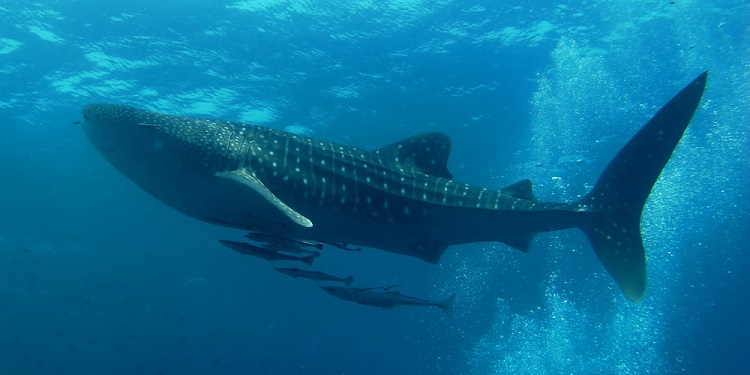
Tribes in Mozambique tell a similar story in which one of the gods was so thrilled to see a Whale shark swimming underneath his boat during a visit to Earth that he scattered silver coins over the shark.
Mexican legend says that an ancient ceramic statue of a Mayan priestess is modeled on the Whale shark, thanks to its wide, toothy mouth, irregular pattern of dots, and white stripe on the figure’s torso that could represent the shark’s dorsal fin.
FAQ’s
Is a Whale Shark a Mammal?
Sharks are not mammals, belonging instead to a group of cartilaginous fishes. Whale sharks are so-named purely because of their size and are fish, not whales.
Is a Whale Shark a Shark or a Whale?
A Whale shark is a shark, not a whale.
How Many Whale Sharks Are Left?
It’s thought that there are roughly 128,000 to 200,000 mature Whale sharks left in the oceans. However, studying and tracking these magnificent creatures is challenging because of their vast range.
Final Thoughts
Did you enjoy our guide to the mysterious and enigmatic Whale shark?
Whale sharks are the biggest fish in the ocean and are a popular tourist attraction in many countries. Unfortunately, fishing and habitat destruction by ocean traffic and pollution has seen a massive decline in the numbers of these gentle giants. The Whale shark is now listed as endangered by the IUCN.
You can help to fund essential further research into Whale shark behavior and numbers by supporting the WWF and symbolically adopting one of these remarkable, ancient creatures before it’s too late.
Have you ever seen a Whale shark? Where did you see it? Tell us about your experience in the comments box below.












